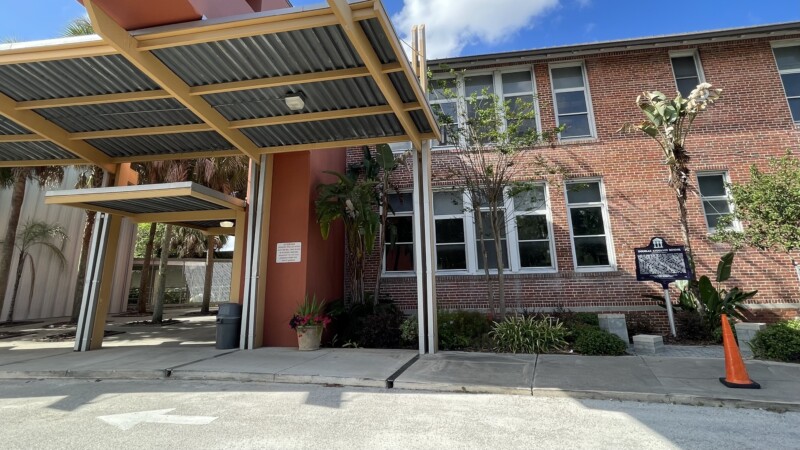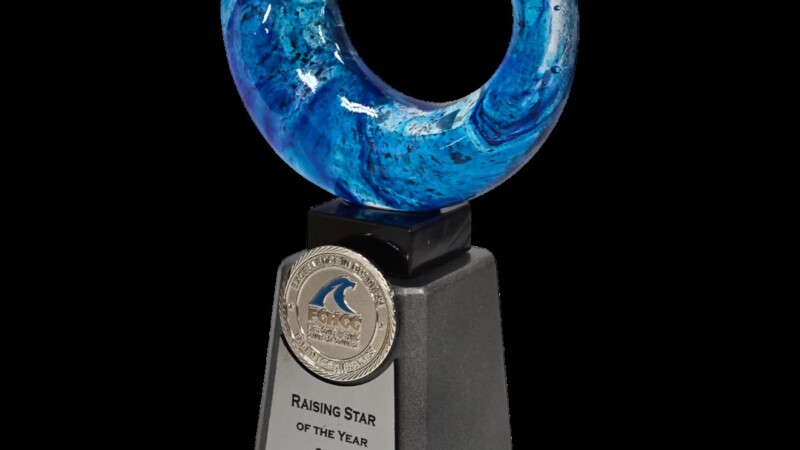An F/A-18A Hornet wears a distinctive two-tone paint job as it perches in front of the National POW/MIA Memorial and Museum at Jacksonville’s Cecil Airport. Its tail fins bear insignias for Navy Strike Fighter Squadron 106.
The sleek jet is the next step in an $80 million-plus plan to enlarge the memorial and museum dedicated to all sailors and soldiers who are missing in action or who spent time in a foreign POW camp.
Along with commemorating the squadron that once flew out of Cecil when it was a Navy base, the just-restored jet also memorializes Capt. Scott Speicher, who flew with them for five years until his deployment overseas ended with him shot down on the first day of the Gulf War on Jan. 17, 1991.
The Orange Park resident was first listed as missing in action, then as a POW before it was learned that he had been killed in action. His remains were brought back to Jacksonville for burial in 2019. Now in honor of the pilot nicknamed “Spike,” employees at Boeing’s maintenance operation at Cecil Airport restored this F/A18A to commemorate Speicher and the base he called home.

Boeing teammate and Navy veteran Daniel Mastrolia checks out the restoration work that he and co-workers did on the commemorative F/A-18A now on display at Cecil Airport’s National POW/MIA Memorial. | Dan Scanlan, Jacksonville Today
More than 20 volunteers worked on weekends and time off to complete the restoration as Boeing donated $10,000 to pay for supplies and provided the hangar space. Boeing teammate and Navy veteran Daniel Mastrolia called the restoration “fantastic.”
“I drive by it every morning and I have mixed emotions,” Mastrolia said. “Sometimes I yell at the airplane because it was a nine-month restoration project every Saturday. … It was a huge part of my life. I love seeing it here, and it is just the great ending to a great story.”
Buddy Harris, National POW/MIA Memorial and Museum spokesman, said it is emotional to see the F/A18 next to an A7 Corsair that also honors those that also flew out of Cecil. The aircraft display is the biggest step so far in plans to turn the land around the former base’s chapel, where Speicher was married, into a proper remembrance of military men and women once imprisoned or still missing.
“It is even more emotional when someone shows up,” he said. “Every time I have been here, people have walked around here and they have gotten even more emotional because they bring their experiences and you want to recreate your experience and what you have done, whether with the A7 and F/A18. This is about Cecil Field. This part of the museum is about Cecil Field.”
Speicher remembered
A Forrest High School and Florida State University graduate, Speicher was stationed at Cecil Field Naval Air Station as a pilot with the VFA-106 “Gladiators,” an F/A-18 squadron. He was one of the first pilots to launch for Operation Desert Storm.
An Iraqi MiG shot him down, but he apparently ejected, a CIA report said. Speicher did not survive. His status shifted from MIA to POW until his remains were found a decade later and he was laid to rest in 2019 at Jacksonville Memory Gardens.
In 1999, while Speicher’s status was still unknown, the U.S. Navy shut down the base where he had been stationed.
The base was turned over to the city for development and became a business park and commercial airport, with Boeing a major part of it.
The field has facilities to transform F/A-18 Super Hornets into flight demonstration aircraft for the Navy’s Blue Angel squadron, and it also converts retired Air Force F-16s into combat training and autonomous aerial targets. For more than two decades, its maintenance facility also has done Department of Defense contract structural repairs for F/A-18 A-F and EA-18G flight control surfaces, with about 350 employees, Boeing said.
The ex-base is more recently home to the memorial park, set on 26 acres about 3 miles west of Boeing’s facilities.

The planned layout of the National POW/MIA Memorial and Museum at Cecil Airport. The base chapel and aircraft display are on the right. The planned USS Saratoga replica and memorial museum are on the left. | Dan Scanlan, Jacksonville Today
Harris said it is imperative that a site honor the 140,000 POWs since World War II and more than 80,000 still classified as MIA — as well as provide a place where families “can find comfort and reflect.” Ground was broken in early 2020 next to the former Navy base’s Chapel of the High Speed Pass to officially begin the estimated $82 million National POW/MIA Memorial and Museum.
The memorial site at 6112 POW-MIA Memorial Parkway already had a Hero’s Walk of Honor, a starburst metal display of aircraft and a granite base seal of the former Master Jet Base. After the chapel was restored, four concrete pads for restored aircraft were laid. The walkways between them are a miniature duplicate of the base’s runways, Harris said.
“It’s an emotional experience, and now to see it being rejuvenated the way it is is even more of an emotional experience,” he said.
The Corsair II was the first plane restored after it was shipped in 2019 from Arkansas and repainted to look like it had been part of Cecil’s VA-174 Replacement Air Group. That is when Mastrolia decided to help the memorial restore the F/A18, which had been on display next to Cecil Airport’s flight control tower.

The F/A-18A sits in front of the Jacksonville Aviation Authority’s flight center at Cecil Airport. | Boeing
“I knew that the chapel would be getting custody of the Hornet and they needed help, so I stepped up, got a lot of Boeing volunteers and we executed the plan,” Mastrolia said. ” This is a homage to not only Scott Speicher, but to all the POW/MIAs in the United States.”
Harris believes “Scott would be tremendously proud of” the airport authority giving the plane to the museum to restore.
“It’s kind of a crowning achievement. It’s my tremendous honor to be a part of it and keep his memory alive,” said Harris, who attended Speicher’s wedding at this base chapel. “Scott is one of the original guys in the Walk of Honor, which actually created this whole museum. Without those original MIA guys over there, this would not have come to fruition. Scott is a huge part of my life and a very emotional part of my life.”

After restoration by Boeing employees at its Cecil Airport facility, this F/A-18A Hornet was towed to the National POW/MIA Museum and Memorial. | Boeing
Towed from Boeing’s facility to the 26-acre National POW/MIA Memorial and Museum at 6112 POW-MIA Memorial Parkway, the Hornet now shines next to the A-7A Corsair II jet, similar to those used by the Navy in the 1980s.
Next up for display is an ex-Navy S-3 Viking, arriving in the next few months after NASA duty, Harris said.
“It’s in spectacular shape so it doesn’t need to be refurbished like these two did, and we are expecting it hopefully by this summer,” Harris said.
The search is on for an A-4 Skyhawk, many of which also flew out of the base, to fill the fourth pad. Memorial officials plan to have the full aircraft display done within a year. The site already includes a memorial walk paved with bricks donated by families and friends of POWs and those still missing in action.

Buddy Harris, right, spokesman for the POW/MIA Memorial and Museum, and Boeing teammate and Navy veteran Daniel Mastrolia talk in the shade of the commemorative F/A-18A Hornet on display at the Cecil Airport site. | Dan Scanlan, Jacksonville Today
Then comes the biggest parts of the memorial, starting with a quarter-scale replica of the USS Saratoga, an aircraft carrier previously based at Naval Station Mayport. That would be in a landscaped pool to be added behind the aircraft. The final part of the site is the planned 160,000-square-foot POW/MIA museum with an MIA Hall and a Sanctuary for Remembrance and gardens. Construction should be underway by 2025, Harris said.
“It’s all donations,” he said. “We get no government fundings because we want this to be a private organization and we don’t want anybody dictating what we can and can’t do. We want the people to dictate what we can and can’t do. This is for the people and it’s going to be for everybody.”
For more information about the memorial, go to powmiamemorial.org.
9(MDEwNzczMDA2MDEzNTg3ODA1MTAzZjYxNg004))







